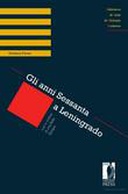Explore

Gli anni Sessanta a Leningrado. Luci e ombre di una Belle Époque
Stefania Pavan
2009
Il volume propone un ritratto di Leningrado degli anni Sessanta, della sua vita culturale nell'Unione Sovietica, in quegli anni attraversata da una forte speranza di cambiamento. Leningrado, oggi San Pietroburgo, è erede e testimone della parabola della 'speranza sovietica' di un mutamento autentico, del suo evolversi e inevitabile esaurirsi. Stefania Pavan, attraverso l'analisi dei versi di Iosif Brodskij, disegna il percorso che ha condotto l'intelligencija di Leningrado nel 'disvelare' le proprie istanze, nel dare forma alla coscienza intellettuale della Città, e che l'ha vista costretta ad adottare successivamente la via inversa, a 'celare' in uno spazio semivisibile e tramite infinite modalità del 'samizdat', i valori, i nomi e le immagini della speranza del cambiamento. Con l'analisi delle particolarità linguistiche di La feccia, uno dei racconti 'classici' di Boris Ivanov, Simonetta Signorini propone una micro-storia della lingua russa negli anni Sessanta, alla quale lo studio di Ljudmila Zubova condotto sui versi di Viktor Sosnora dà un utile contributo. Il saggio di Irina Dvizova mette in evidenza un aspetto della cultura di Leningrado che è da considerare molto attuale sia come argomento che come metodo di lettura della storia letteraria: il rapporto fra la città e il Museo Dostoevskij.
This book is included in DOAB.
Why read this book? Have your say.
You must be logged in to comment.
Rights Information
Are you the author or publisher of this work? If so, you can claim it as yours by registering as an Unglue.it rights holder.Downloads
- 88 - pdf (CC BY-NC-ND) at OAPEN Library.
- 84 - pdf (CC BY-NC-ND) at fupress.com.
Keywords
- History
- History: specific events & topics
- Humanities
- Language
- Letteratura
- letteratura straniera
- Linguistics
- literary essays
- Literature
- Literature & literary studies
- open access
- Poesía
- Poetry
- Prose: non-fiction
- Russia
- Slavistica
- Social & cultural history
- thema EDItEUR::C Language and Linguistics::CF Linguistics
- thema EDItEUR::D Biography, Literature and Literary studies::DN Biography and non-fiction prose::DNL Literary essays
- thema EDItEUR::N History and Archaeology::NH History::NHT History: specific events and topics::NHTB Social and cultural history
Links
DOI: 10.26530/OAPEN_341468Editions

